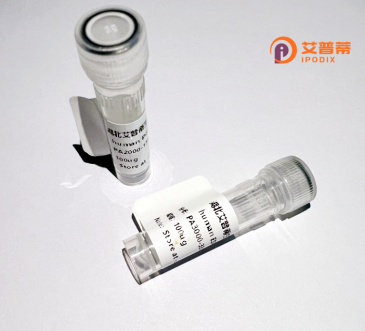
| 纯度 | >90%SDS-PAGE. |
| 种属 | Human |
| 靶点 | ARMET |
| Uniprot No | P55145 |
| 内毒素 | < 0.01EU/μg |
| 表达宿主 | E.coli |
| 表达区间 | 25-182aa |
| 氨基酸序列 | LRPGDCEVCI SYLGRFYQDL KDRDVTFSPA TIENELIKFC REARGKENRL CYYIGATDDA ATKIINEVSK PLAHHIPVEK ICEKLKKKDS QICELKYDKQ IDLSTVDLKK LRVKELKKIL DDWGETCKGC AEKSDYIRKI NELMPKYAPK AASARTDL |
| 分子量 | 18.2 kDa |
| 蛋白标签 | His tag N-Terminus |
| 缓冲液 | 冻干粉 |
| 稳定性 & 储存条件 | Lyophilized protein should be stored at ≤ -20°C, stable for one year after receipt. Reconstituted protein solution can be stored at 2-8°C for 2-7 days. Aliquots of reconstituted samples are stable at ≤ -20°C for 3 months. |
| 复溶 | Always centrifuge tubes before opening.Do not mix by vortex or pipetting. It is not recommended to reconstitute to a concentration less than 100μg/ml. Dissolve the lyophilized protein in distilled water. Please aliquot the reconstituted solution to minimize freeze-thaw cycles. |
以下为3篇关于重组人ARMET蛋白的关键文献摘要:
---
1. **文献名称**: "ARMET is a novel ER stress-responsive factor protecting cells against apoptosis"
**作者**: Tadimiti A. et al. (2003)
**摘要**: 首次发现ARMET在内质网(ER)应激条件下(如缺氧或营养剥夺)显著上调,通过抑制Caspase-3活性减少细胞凋亡,揭示其在ER应激保护中的关键作用。
---
2. **文献名称**: "MANF/ARMET prevents dopamine neuron loss in a rat Parkinson’s disease model"
**作者**: Palmová E. et al. (2008)
**摘要**: 在帕金森病大鼠模型中验证重组ARMET蛋白的神经保护功能,证明其通过调节ER应激通路显著减少多巴胺能神经元退变,改善运动功能障碍。
---
3. **文献名称**: "ARMET structure reveals a unique surface for targeting ER stress-related diseases"
**作者**: Liao Y. et al. (2019)
**摘要**: 通过X射线晶体学解析ARMET蛋白的三维结构,发现其表面存在独特的疏水结合口袋,为开发靶向ER应激相关疾病(如糖尿病、神经退行性疾病)的药物提供结构基础。
---
**备注**:ARMET也称为MANF(Mesencephalic Astrocyte-Derived Neurotrophic Factor),部分研究可能以“MANF”命名。
ARMET (arginine-rich, mutated in early tumors), also known as MANF (mesencephalic astrocyte-derived neurotrophic factor), is a multifunctional protein encoded by the *ARMET* gene. Initially identified for its association with chromosome deletions in tumors, it was later recognized as a secretory neurotrophic factor with roles in neuroprotection, anti-apoptosis, and anti-inflammatory responses. Structurally, ARMET contains a conserved N-terminal saposin-like domain and a C-terminal region rich in arginine residues. It exists in two isoforms: a longer endoplasmic reticulum (ER)-resident form involved in regulating ER stress and unfolded protein response, and a shorter secreted form that acts extracellularly to support neuronal survival and modulate immune activity.
Research highlights ARMET's therapeutic potential in neurodegenerative disorders (e.g., Parkinson’s and Alzheimer’s diseases), diabetes, and ischemic injuries. Its ability to reduce ER stress and inflammation makes it a key target for metabolic and age-related diseases. Recombinant human ARMET protein, produced via bacterial or mammalian expression systems, is widely used in mechanistic studies and preclinical trials. Recent studies also explore its role in cancer progression and immune regulation, though its dual intracellular/extracellular functions necessitate further investigation. Efforts to optimize its stability and delivery are ongoing to advance clinical applications.
×